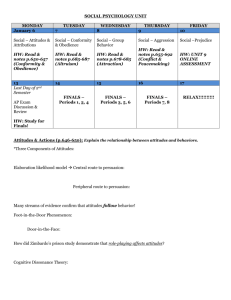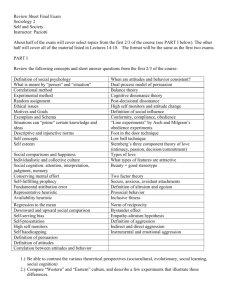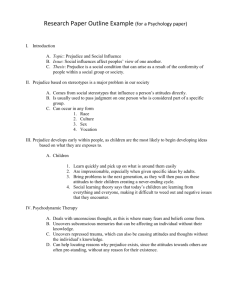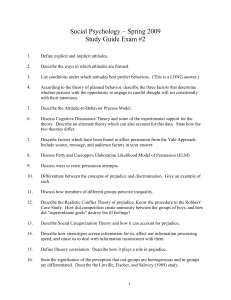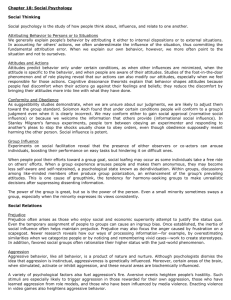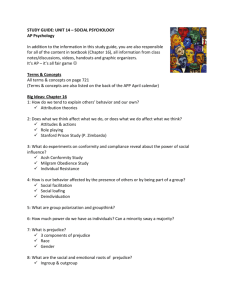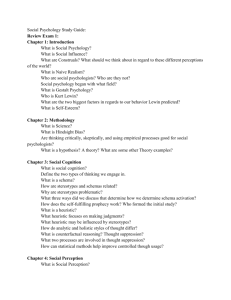How Prejudiced Are People?
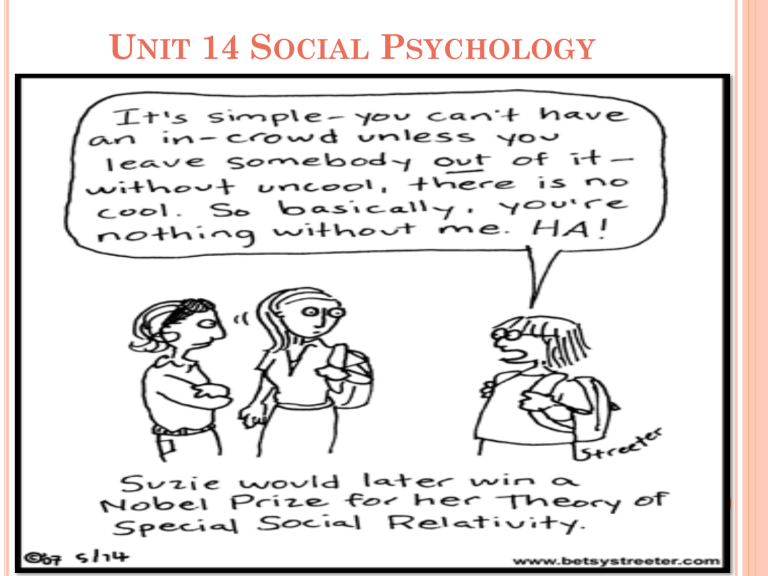
U NIT 14 S OCIAL P SYCHOLOGY
W HAT I S S OCIAL
P SYCHOLOGY ?
Social psychologists
Study social forces that explain why the same person acts differently in different situations
Personality psychologists
Study personal traits and processes that explain why people may act differently in the same situation
Fundamental Attribution Error tendency for observers, when analyzing another’s behavior, to underestimate the impact of the situation and to overestimate the impact of personality traits
How do we become more aware of our own personal style?
What are the real world implications of the f.a.e?
A TTITUDES & A CTIONS
Attitudes
Behavior
attitudes : feelings, based on our beliefs that influence our behavior
If we believe someone is mean we may feel dislike and then act unfriendly toward them
Behavior
Attitudes
…but, there is evidence that attitudes FOLLOW behavior
Attitudes follow behavior…
If someone convinced you to act against your beliefs, you’d change your belief
(attitude) to match your action.
Foot-in-the-door phenomenon
People agreeing to a small request will find it easier to later agree to a larger one
Principle works for negative and positive behavior
ATTITUDES FOLLOW BEHAVIOR
After US schools desegregated in ‘54,
Cooperative actions, such as those performed by people on sports teams feed mutual liking.
Americans expressed lower levels of racial prejudice.
Role
: a set of expectations about a social position, defining how those in the position should act.
Zimbardo Prison Experiment
A CTIONS A FFECT A TTITUDES
Cognitive dissonance theory
“ the theory that we act to reduce the discomfort (dissonance) we feel when two of our thoughts (cognitions) are inconsistent.
If you do a behavior that is “bad” you change your attitude about the behavior.
P RACTICE Q UESTION (… ON THE TEST …)
Cognitive dissonance theory attempts to explain why a) people who act differently than their attitudes tend to change their attitudes.
b) people who act against their attitudes tend to change their behavior c) agreeing to a small request increases the likelihood that we will agree to a larger request d) people talk one way and act another
SOCIAL INFLUENCE
( PG . 382) chameleon effect:
Asch’s Conformity Study:
define:
method:
deceived:
# of participants: task:
What is the decision you have to make during the 3 rd trial? results:
when answering alone… when in the room with confederates who answered incorrectly…
more likely to conform when…
confederate participant confederate
Asch’s Conformity Study:
define: adjusting our thinking or behavior to go along with a group method: standard
deceived: a study on visual perception
# of participants: task: you & 5 others state, 1 by 1, which of 3 lines is the same as a standard 1. Easy.
What is the decision you have to make during the 3 rd trial? the 5 people before you all give a wrong answer to the same results: easy question…do you go along or be the oddball and answer differently?
when answering alone… wrong less than 1% of the time
when in the room with confederates who answered incorrectly… wrong 33% of the time
more likely to conform when… feel insecure admire the groups’ status group has at least
THREE everyone else have not already agrees committed to an culture answer know others will observe our behavior
M ILGRAM ’ S O BEDIENCE S TUDY define:
Method:
https://www.youtube.com/watch?v=16QMQXIjYVU
Intro to Obedience (5 min)
“fake” study – https://www.youtube.com/watch?v=dNo-2AXzHAs
Milgram Replication (14 min) draw randomly to determine –
teacher task – learner taskteacher after 1 st wrong answer:
teacher after 8 th wrong answer: learner after 10 th wrong answer:
You want to stop hurting this person but the experimenter says:
“…”
Final shock v:
At what level would you stop?
At what level would most people (say) stop?
RESULTS:
Obedience is highest when… (4)
M ILGRAM ’ S O BEDIENCE S TUDY define: changing a behavior to follow a command
Method
“fake” study – effect of punishment on learning draw randomly to determine – who will be “teacher” & “learner”
teacher task – test learner on word pairs; if wrong = shock them learner taskto learn the words….actually an actor (confederate) teacher after 1 st wrong answer: 15 volts / slight shock
teacher after 8 th wrong answer: 120 volts / moderate shock learner after 10 th wrong answer: 150 volts / strong shock
You want to stop hurting this person but the experimenter says:
“You have no choice. You must go on.”
Final shock v: 450 volt
At what level would you stop? your opinion
At what level would most people (say) stop? After 1 st hearing
“learner” in pain
RESULTS
Obedience is highest when…
O BEDIENCE HIGHEST WHEN …
Person giving order is close by & was an authority figure
The authority figure was associated with a respected institution
The victim was depersonalized or far away
There was no role model of defiance minority influence: you can sway the majority if you hold firmly to your beliefs – power of committed individual is as strong as power of the group
social facilitation: stronger responses on a well-learned task when other people are watching you. social loafing: tendency for people in a group to exert less effort when working toward a common goal deindividuation:
The loss of self-awareness in a group group polarization:
When a belief you hold gets stronger after discussing it with a like-minded group
group polarization
group think: when no one in a group speaks up to voice a different opinion b/c they want the group to get along
P REJUDICE
H OW P REJUDICED A RE P EOPLE ?
Prejudice
belief that includes negative stereotypes
Stereotype
an overgeneralized belief about a group
Discrimination
negative behavior toward a group
Prejudice
How Prejudiced Are People?
Prejudice
How Prejudiced Are People?
Prejudice
How Prejudiced Are People?
Prejudice
How Prejudiced Are People?
Prejudice
How Prejudiced Are People?
Prejudice
How Prejudiced Are People?
implicit racial associations: unconscious / unaware just-world phenomenon: believing that the world is just
& therefore people get what they deserve in-group/out-group: “us” / “them” in-group bias: tendency to favor our own group scapegoat theory: theory that prejudice offers an outlet for anger by providing someone to blame other-race effect: the tendency to recall faces of one’s own race more accurately than faces of other races.
Aggression
any physical or verbal behavior INTENDED to hurt another
BIOLOGY of AGGRESSION
Genetics: identical twins report bad temper more in common than fraternal twins
T HE B IOLOGY OF A GGRESSION
Neural Influences
frontal lobe damage or diminished activity
frontal lobe not fully developed
amygdala stimulated
Biochemical Influences
hormones (testosterone), alcohol,
#30. P SYCHOLOGICAL OF A GGRESSION
Frustration-aggression principle
If aggression is rewarded it continues
Observing models of aggression
Acquiring social scripts – culturally modeled guide for how to act in certain situations
P SYCH J OURNAL
For Mon 10/19, answer the following questions in your journal:
1) What is the just-world theory?
2) How does the class data match mine? How were our
#s the same/different?
Husband
5.4
Wife
1.2
Lover 1
3.5
Lover 2
4.3
Ferryboat
4.8
Highway man
2.2
3)What was my score on the just world survey?
What does a high vs low score on the just world survey mean?
If someone had a high survey score (70+) who did they probably blame the most in the scenario? Why?
Thurs 10/22: Love Attitude Scale : Take survey & score
T HE P SYCHOLOGY OF A TTRACTION
W HY DO WE FALL IN LOVE WITH SOME PEOPLE BUT NOT OTHERS ?
3 ingredients to liking someone:
Proximity
Geographic nearness
Mere exposure effect
Just being around someone makes you like them
Similarity
friends & couples are far more likely to share things in common
attitudes, beliefs, interests, age, religion, race, education, intelligence, smoking behavior, economic status
Physical attractiveness
its what initially draws us symmetric / youthful / average
R OMANTIC L OVE https://www.youtube.com/watch?v=sjLDomII6No
Rules of Attraction
H OW DOES LOVE CHANGE OVER TIME ?
passionate love
all-consuming
companionate love
Deep affection
Equity
Getting out of the relationship what you put in
self-disclosure
Telling secrets about yourself to your loved one
Bystander Effect
